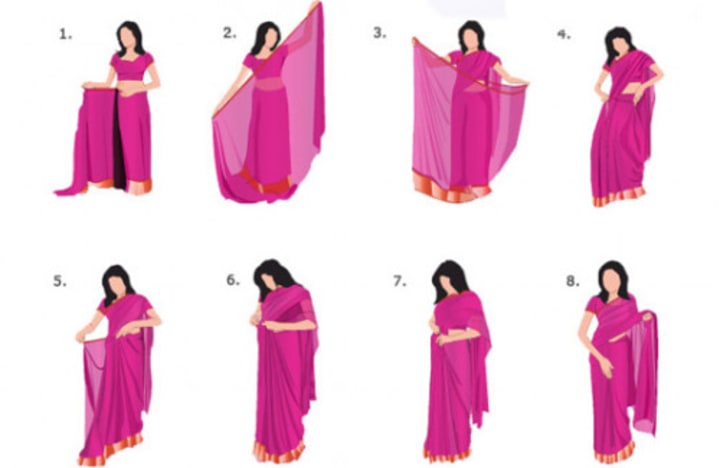
What is a sari?
The sari goes back to 2800-1800 BC where cotton and silk were woven in the northern parts of India and made into meters of cloth used to drape over women. Typically 5-9 yards of fabric are worn in special ways to comfortably cover a women's body. The three-piece ensemble is made up of a bando type cloth, representing the blouse, which covers the chest area, the lower garment that is decoratively folded pleats that fall between the legs, acting as a free-flowing skirt, and the upper garment drape that falls over the shoulder and traditionally used to cover the women head. There are multiple ways to wrap the sari as over time and through the dense, diverse cultures spanning the country cultural differences defined how women should be represented through the way they dressed.
With extreme weather throughout the year, the sari plays a practical role for women as it is cooling for summer temperatures. Women can wrap the sari more loose-fitting and free-flowing so they can get air and free movement. In winter months women wrap the sari more tightly and can use the extra cloth to wrap themselves in warmth. In addition, the quality of saris tends to last long and so each piece can be passed down over generations. One piece of fabric could be used for so many purposes, making it the ideal and most common piece of clothing worn by women in India. Over time, the sari has become a cultural symbol with politicians and staff of high ranking businesses dressing in saris displaying elegance and professionalism. Other styles of clothing like the lengha and the Punjabi suit came to be in the 18th and 19th century allowing for easier ways to dress and adding greater variety to the fashion industry. All while remaining supportive of the cultural norms, the lengha is made up of the blouse, a skirt, and a scarf similar to the Punjabi suit made up of a top, pants and a scarf.
The most common style of draping the sari is known as the 'Nivi Style,' which is how we will tie the sari in this instructional blog.
Ever consider using a sari in your ensemble or as your outfit? Don't let the huge sheet of fabric intimidate you! It's a simple process once you get a hang of it. Check it out below.
What You'll Need
- Sari
- Blouse
- Petticoat
- Shoes you'll be wearing with your outfit (if any)
- Safety pins (minimum 5, use more for security)
Optional:
- A fan (it can get hot!)
- A helping hand
Let's Get Started
- Find a clean area to set up and begin wrapping. Slip into your petticoat and blouse. Make sure you tie your petticoat tightly around your waist—you'll be tucking the sari fabric into the petticoat to hold it up.
- Put your shoes on to measure the height you want your sari to fall. If you're wearing flats or no shoes, tuck a little more fabric into your petticoat to get the perfect height. You don't want the bottom of the sari dragging on the floor. Take the sari fabric and wrap it one time around your waist, tucking it into your petticoat. Finish where you first started. One full wrap around.
- Take the other end of the sari/the drape/the heavier end/the decorative end and toss it over your shoulder to your desired length and pin it there, temporarily. The sari will seem loose as extra fabric will gather in front of you. You will use the loose fabric to make your pleats.
- Make your pleats! Fold the fabric together to give a pleated look. Start with the right most side of the piled fabric. Use the width of four fingers (you will likely have five to seven pleats). Once you get your pleats to your desired width and look, pin your pleats together and tuck it into your petticoat, just underneath your belly button. The goal is to ensure they are secure and not dragging the outfit down. Make sure you tuck the fabric in it securely and pin it to avoid unraveling.
- Reminder step: did you pin your pleats to the petticoat for extra support (so it doesn't come un-tucked!)?
- Now, you can drape the remaining fabric over your shoulder to your desired look. Some like to leave it open, other like to pleat it and pin it (in case you're dancing the night away).
- Add accessories to dress up your sari for any occasion.
More Info

Check out this detailed description for more info: Simple Step by Step Draping Guide.
If you have any questions about where to find outfits or any general questions feel free to ask. Thanks for reading!






Comments
There are no comments for this story
Be the first to respond and start the conversation.